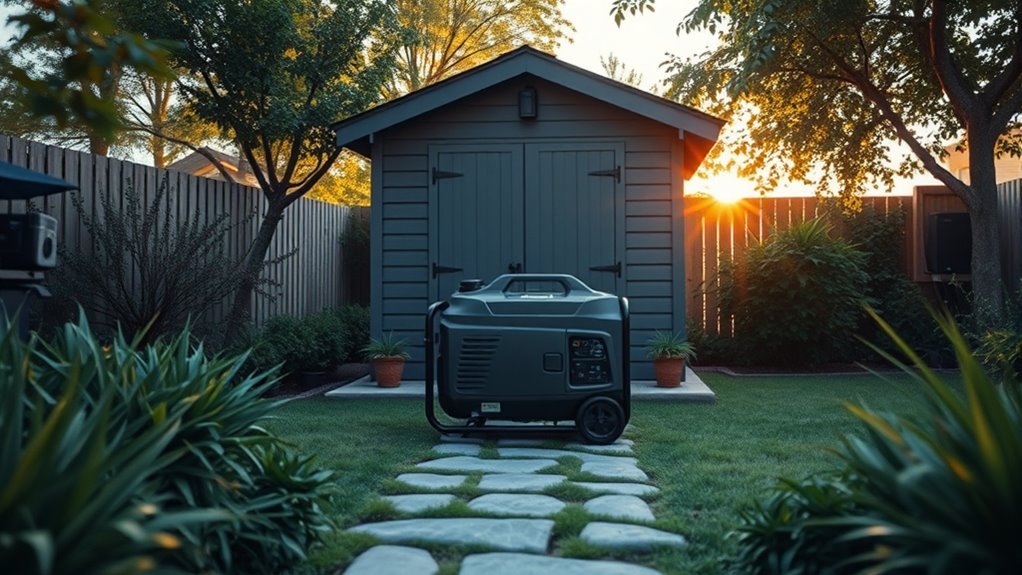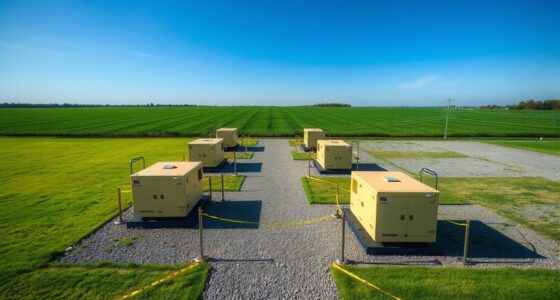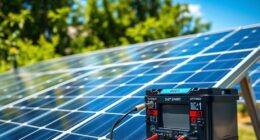Many underestimate the importance of proper generator placement, thinking it’s safe to set it anywhere outside—this is a myth. To maximize safety and efficiency, keep it at least 20 feet from your home, on a flat, ventilated surface, and shielded from direct sun or rain. Proper placement reduces noise and fuel waste while preventing safety issues. Stick to these key rules, and you’ll guarantee ideal performance—continue to learn how to perfect your setup.
Key Takeaways
- Proper placement ensures safety, better ventilation, and reduces noise pollution, debunking the myth that any outdoor spot is safe.
- Keep the generator at least 20 feet away from occupied spaces to prevent safety hazards and noise disturbances.
- Using barriers or soundproof enclosures effectively minimizes noise, contrary to the misconception that placement doesn’t impact noise levels.
- Placing the generator on a flat, stable surface and avoiding soft or uneven ground enhances performance and longevity.
- Following placement guidelines from trusted resources ensures safe, efficient operation and dispels myths about improper generator setup.
Common Misconceptions About Generator Placement

Many people believe that placing a generator anywhere outside their home is safe, but this is a common misconception. Proper placement critically impacts fuel efficiency, as positioning the generator in a well-ventilated, sheltered area helps it run smoothly without working harder. Incorrect placement can also increase noise levels, making the generator more disruptive. To achieve noise reduction, avoid placing the unit close to windows, doors, or neighbor’s property. Instead, position it away from living spaces and use barriers or enclosures designed to dampen sound. Remember, the right placement isn’t just about safety—it enhances performance and minimizes disturbances. Proper setup ensures you get the most out of your generator while maintaining safety and comfort for everyone around you. Additionally, following generator placement guidelines helps ensure safety and optimal operation.
Essential Rules for Safe and Efficient Setup

To guarantee your generator operates safely and efficiently, you must follow essential setup rules from the start. Ensure proper ground clearance to prevent flooding or moisture damage, which can compromise performance and safety. Place your generator on a flat, stable surface, avoiding uneven or soft ground. This stability reduces noise and vibration, aiding noise reduction. Keep the unit at least 20 feet away from your home or any occupied structures to prevent exhaust fumes from entering living spaces. Additionally, ensure adequate ventilation around the generator; restricted airflow can cause overheating. Following these rules not only enhances safety but also optimizes efficiency, prolongs your generator’s lifespan, and minimizes noise disruptions. Proper placement is key to reliable operation and safety.
Quick Tips to Optimize Your Generator Position

Optimizing your generator’s position guarantees safe operation and peak performance. To improve fuel efficiency, place the generator on a level, solid surface away from debris and obstructions. Keep it sheltered from direct sunlight and rain to prevent overheating and corrosion. Position the unit at least 20 feet from your home or work areas, facing away from windows to reduce noise. Use barriers or soundproof enclosures to minimize noise pollution further. Ensure proper ventilation by avoiding cramped spaces, which can cause overheating and reduce efficiency. Regularly check and adjust the placement as needed, especially if you notice increased noise or fuel consumption. By following these quick tips, you’ll enhance both your generator’s fuel efficiency and noise reduction, ensuring safer, quieter operation. For optimal performance, consider the soundproof enclosures and placement guidelines that help reduce operational noise and improve overall efficiency.
Frequently Asked Questions
Can Generator Placement Affect Fuel Efficiency?
Yes, generator placement can affect your fuel efficiency. Proper placement optimization guarantees better airflow and reduces heat buildup, which helps your generator run more efficiently. When you position your generator correctly, it minimizes fuel consumption by preventing unnecessary strain and overheating. Avoid blocking ventilation or placing it in enclosed spaces, as these can lead to increased fuel use and decreased performance. Optimizing placement is key to saving fuel and extending your generator’s lifespan.
Are There Specific Distances to Maintain From Windows and Vents?
Yes, you should maintain specific distances from windows and vents to guarantee ventilation safety and proper window clearance. Keep your generator at least 20 feet away from windows, doors, and vents to prevent dangerous carbon monoxide buildup. This distance helps ensure that exhaust fumes don’t enter your home, safeguarding your health and maintaining proper ventilation safety. Always follow manufacturer guidelines and local regulations for ideal placement and safety measures.
How Does Terrain Impact Generator Stability and Operation?
Like a ship steering rocky waters, your generator’s stability depends heavily on terrain effects. Uneven or sloped ground can cause wobbling or shifting, compromising safe operation. To guarantee stability considerations, place your generator on a flat, solid surface away from steep inclines. Avoid soft soil or gravel, which can lead to instability. Proper placement minimizes risks, ensures efficient operation, and prolongs your generator’s lifespan.
Is It Necessary to Consider Local Noise Ordinances?
Yes, you should consider local noise ordinances to avoid noise concerns and guarantee legal compliance. Check your area’s regulations on acceptable noise levels and quiet hours, especially if your generator runs frequently or during nighttime. Ignoring these rules can lead to fines or complaints from neighbors. By planning your generator placement with noise ordinances in mind, you protect your community relationships and stay within legal boundaries.
Can Improper Placement Cause Carbon Monoxide Hazards?
Improper placement of your generator can definitely cause carbon monoxide hazards. If you don’t guarantee proper generator ventilation and maintain adequate exhaust clearance, dangerous fumes can accumulate indoors or in poorly ventilated areas. Always position your generator outdoors, away from windows and vents, and keep exhaust clearance sufficient to prevent CO buildup. This way, you protect yourself and your family from potentially life-threatening carbon monoxide poisoning.
Conclusion
By keeping these myths in check and following the essential placement rules, you’ll navigate the generator landscape with confidence. Think of your setup as a well-tended garden, where each careful placement nurtures safety and efficiency. With quick tips guiding your hand, you’ll avoid the rocky patches and enjoy a smooth, reliable power flow. Trust in these insights, and you’ll find your generator working harmoniously, illuminating your space without a hitch.









